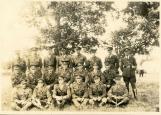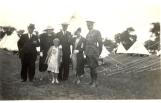1
The BungalowCirca 1932
Sussex, New Brunswick, Canada
 Credits:
Credits:Kings County Historical Society
Crook and Marteinson, A Pictorial History of the 8th Canadian Hussars (Princess Louise's)
Ganong, AT, A Historical Outline of the Regiment
2
7th Machine Gun BattalionCirca 1928
Sussex, New Brunswick, Canada
 Credits:
Credits:Kings County Historical Society
Militia General Orders
3
Merrit Cup Challenge1930
Sussex, New Brunswick, Canada
 Credits:
Credits:Association of the 8th Canadian Hussars (Princess Louise's) Inc
Crook and Marteinson; 125 Years of Service, The Pictorial History of the 8th Canadian Hussars (Princess Louise's)
Ganong, AT, A Historical Outline of the Regiment
4
8th Hussar Officers in front of the Bungalow1934
Sussex, New Brunswick, Canada
 Credits:
Credits:Clifford Kennedy
Militia General Orders
Crook and Marteinson, A Pictorial History of the 8th Canadian Hussars (Princess Louise's)
Ganong, AT, A Historical Outline of the Regiment
5
Hosting Visitors to Camp.1934
Sussex, New Brunswick, Canada
 Credits:
Credits:Clifford Kennedy
Crook and Marteinson, A Pictorial History of the 8th Canadian Hussars (Princess Louise's)
6
Fixing the flat- On Exercise in 19381938
Sussex, New Brunswick, Canada
 Credits:
Credits:Ganong, AT, A Historical Outline of the Regiment
Crook and Marteinson, A Pictorial History of the 8th Canadian Hussars (Princess Louise's)
7
The period between the First and Second World Wars was not an easy time for the militia in Canada. It was highlighted by general apathy towards anything military, severe lack of funds accelerated by the Depression in the 1930's and lack of political will to face the fact that another threat to world peace was rapidly growing in Europe and that the First World War had done little to settle the growing nationalist ideals in a number of centers of Europe.During the year 1920, most militia units were disbanded and/or reorganized, some with different names and other who managed to re-establish their units with the same name. Such was the case of the 74th Battalion which became the New Brunswick Rangers while the 8th Hussars managed to keep their name intact. And during 1921 these were the only two units to come into Camp Sussex to train at the annual summer camp. Much damage had been done to the stables and messes constructed before the war, but both units trained successfully while repairs were carried out on the Bungalow and new stables erected, all at the expense of the unit officers. The 8th Hussars actually submitted a claim to the Federal government for the wartime damages and the cost of repairing the buildings which was finally settled in 1923. They actually received $490 for damage to the Officers Mess and $151 for the Sergeants Mess. However no monies were paid to cover the costs of repairing the cook houses or the stables.
Between 1923 and 1926 funds were so restricted that camps were often limited to officers and NCOs. Daily rates of pay continued to rise but there was so little funding available that most units could not take advantage of it. Over the next decade many schemes were attempted to get the most training possible out of the limited amount of money available. Cavalry units cut the number of horses in half to reduce rental costs, all horses were rented locally to reduce transportation costs, and at one point the Rangers actually offered to split their daily pay rate in half so that double the number of men could come to camp.
The limited size of Camp Sussex was now coming into play more often and training for the Artillery units in the province was often conducted at other centers. The Newcastle and Woodstock Batteries annually travelled to Camp Petawawa to conduct their summer camps and took advantage of the large land masses encompassed in these camps. Provisional Camps for all arms were being conducted there, in Sarcee in Alberta or at Valcartier where representative members from all units would gather to upgrade their military skills.
The summer camps of 1927 to 1930 saw larger numbers able to attend and the training focus was such that units could actually train at a brigade level. A new veterinary hospital was actually opened in the camp in 1929 to provide better care for the horses being brought in to train. This was soon to be a thing of the past as mechanization was looming on the horizon. It is noted in the Hussar Routine orders that the annual dance was still as success and this annual event was to provide the socialites of the surrounding communities the opportunity to shine. This event was carried out for a great number of years.
The expectations of the last few years were rapidly dashed in 1931. Little or no funding was available for any camps, or local training for that matter. Public apathy was at it's highest and the depression was impacting the very essence of the military. Between 1931 and 1936, the volunteer soldier was to continue the military presence without pay. Various schemes were attempted and in the end volunteers carried the day. The NB Rangers volunteered their pay to conducting the summer camp and actually increased the number of nights they trained locally, all without pay or compensation of any kind. Numbers actually increased in the battalion. The Hussars rode to camp and C Squadron traveled the 100 miles from Sackville to Sussex on horse back, something not done since the 1800's. Skill levels of the militia soldier were actually improving in spite of the lack of funded training and in 1935 the machine guns troop of the 8th Hussars travelled to Valcartier and won the national competition, all at the expense of the Commanding Officer.
A number of major changes were to occur in 1936. This was the first year of training conducted using motorized vehicles, all rented at $10 per day from local owners. The day of the horse and its association with the military in the Province of New Brunswick was over, having lasted 111 years in total. Cavalry units in Canada were renamed as Cavalry (Mechanized). Due to the reorganization the NB Dragoons and the 9th Mounted Brigade were eliminated from the Order of Battle. The NB Rangers were training over 400 hundred men at local training but were only able to send less than half to camp that year. These restrictions were to continue for the next few years, but special events continued to keep the focus of the camp alive and well in the soldiers eyes. The NB Rangers received the Kings and Regimental colors now displayed in the Sussex Train Station in 1938, soldiers represented the Battalion at the coronation of King George the VI in England and then in 1939 a number of the units paraded in Saint John in honour of the visit of the King and Queen. Little did they know short weeks later they would be called again to serve their country as World War II started as the German forces smashed across the Polish border, intend on conquering Europe once again.